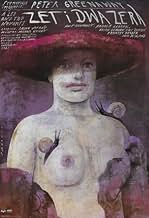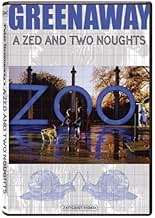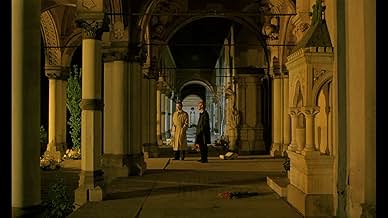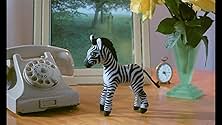VALUTAZIONE IMDb
7,2/10
7983
LA TUA VALUTAZIONE
Gli zoologi gemelli perdono la moglie in un incidente d'auto e diventano ossessionati dagli animali in decomposizione.Gli zoologi gemelli perdono la moglie in un incidente d'auto e diventano ossessionati dagli animali in decomposizione.Gli zoologi gemelli perdono la moglie in un incidente d'auto e diventano ossessionati dagli animali in decomposizione.
- Regia
- Sceneggiatura
- Star
Recensioni in evidenza
All you need to make cinema is a point of view (and of course the view to which it points). Or a frame of reference and the reference which it frames. In Greenaway all these exist together, knowingly, as forms within forms.
A story of twins looking to overcome grief by studying the decay of death is the reference here. Zebras, lizards, swans, we see the empty shells of body decay before the camera. Kept under the scrutiny of our gaze in life, inside cages, they remain under it once dead. At what point do all these symmetries which conjoined together make up the miracle of life stop being the sum of their parts, and by which process; how much of these parts that we understand as the self can be taken out before the self is no longer recognized; and the symmetry once broken, what mystery renews it.
These obscure ruminations are framed against the question of existence, which implies god and pattern. How come that something so systemised, so perfectly designed and evolved from nothing, from amoeba and algea, can come to pass by the whim of chance? Having taken millions of years for creation to unravel its complexity, why does it take a second to destroy it? Which is to ask, at what point does the system, which in hindsight appears ordained and patterned, become random and meaningless.
Various eccentricities are enacted in this process, all pointing to some kind of symbolic nakedness.
When the legless woman gives birth to new life, twins again, the old twins, the blueprint for them, must step aside. The film ends with an poignant thought. Having carefully staged their own death so that the decay that follows may be captured on film, we see how nature intrudes upon this scene and foils the effort.
An atheist himself, Greenaway here gives us a pessimism that cuts deep; no consciousness survives this.
A story of twins looking to overcome grief by studying the decay of death is the reference here. Zebras, lizards, swans, we see the empty shells of body decay before the camera. Kept under the scrutiny of our gaze in life, inside cages, they remain under it once dead. At what point do all these symmetries which conjoined together make up the miracle of life stop being the sum of their parts, and by which process; how much of these parts that we understand as the self can be taken out before the self is no longer recognized; and the symmetry once broken, what mystery renews it.
These obscure ruminations are framed against the question of existence, which implies god and pattern. How come that something so systemised, so perfectly designed and evolved from nothing, from amoeba and algea, can come to pass by the whim of chance? Having taken millions of years for creation to unravel its complexity, why does it take a second to destroy it? Which is to ask, at what point does the system, which in hindsight appears ordained and patterned, become random and meaningless.
Various eccentricities are enacted in this process, all pointing to some kind of symbolic nakedness.
When the legless woman gives birth to new life, twins again, the old twins, the blueprint for them, must step aside. The film ends with an poignant thought. Having carefully staged their own death so that the decay that follows may be captured on film, we see how nature intrudes upon this scene and foils the effort.
An atheist himself, Greenaway here gives us a pessimism that cuts deep; no consciousness survives this.
A Zed and Two Noughts (or Zoo) is Greenaway's best film. Made during the transition between his early experimental short films and his later more narrative (and more celebrated) ones, his free flowing structure is at its best here, fresh, witty and cerebral (some would also say pedantic). In later films, one has the feeling that Greenaway has try to go back to the style set by Zoo, but the results (like in 8 1/2 women) are almost unwatchable. The plot: two biologists twins working in a zoo, specialized in studying the putrefaction of animals, lose their wives in a car accident. They hook up with a strange woman who lost her leg in that accident. Meanwhile, there are references to Vermeer throughout (what does this has to do with zoology, only Greenaway knows), speeded up shots of real rotting animals, Michael Nyman's hypnotic score, and also a girl who learns the alphabet through giant letters that are linked with live animals (for example, z is for zebra, as in a children's book). Deliberately non naturalistic, Greenaway makes from this strange melange a very compelling movie, though undoubtedly very hard to take for some.
A rewarding post modern film about life and decay and the effects of a single moment on a person's life. Great sets and photography by the legendary cinematographer Sacha Vierny, this film makes you ultra aware that you are watching a film, or a sort of theatrical filmed piece. Greenaway is an aquired but very rewarding taste, and no other director makes films as he does. A disturbing somber film for serious fans of modern cinema. Greenaway is a must in your education of film.
Greenaway's obsessions with lists, wordplay, coincidence, sexuality, the surreal, and the explicit (not to mention the "conventionally used" ones like men and women, birth and eating and death, physiology (formal and psychological), and abstraction) come to a head in this film. A bizarre mileau of fancy digressions and focused narrativity create a film which is perhaps too obtuse for first time viewers but is, as far as I'm concerned, the best way to initiate oneself into the "world" of Greenaway.
(Movie quote) - "So, tell me - Is a zebra a white animal with black stripes, or is it a black animal with white stripes?"
Even though I definitely found this 1985, British, "art" film to be something of a "hit'n'miss" production, it was its very striking camera-work by French cinematographer, Sacha Vierny, that certainly helped to elevate it to a position that set it well-beyond the realm of being considered just purely mundane entertainment.
Surreal, eccentric and bizarre (and, yes, at times, quite puzzling) - "A Zed And 2 Noughts" definitely had me wondering, often enough, what kind of a curve director Peter Greenaway was going to hurl at me next with this weird and somewhat disturbing tale of obsession with decaying flesh and the amputation of body parts.
Certainly not a film to please everyone (and certainly not a film with a gripping plot-line) - I, for one, thought "A Zed And 2 Noughts" was well-worth a view simply for the freakish biology lesson that it quite cleverly wedged into its wacky, little story (all at no extra cost).
Even though I definitely found this 1985, British, "art" film to be something of a "hit'n'miss" production, it was its very striking camera-work by French cinematographer, Sacha Vierny, that certainly helped to elevate it to a position that set it well-beyond the realm of being considered just purely mundane entertainment.
Surreal, eccentric and bizarre (and, yes, at times, quite puzzling) - "A Zed And 2 Noughts" definitely had me wondering, often enough, what kind of a curve director Peter Greenaway was going to hurl at me next with this weird and somewhat disturbing tale of obsession with decaying flesh and the amputation of body parts.
Certainly not a film to please everyone (and certainly not a film with a gripping plot-line) - I, for one, thought "A Zed And 2 Noughts" was well-worth a view simply for the freakish biology lesson that it quite cleverly wedged into its wacky, little story (all at no extra cost).
Lo sapevi?
- QuizThis film was Peter Greenaway's first collaboration with cinematographer Sacha Vierny, who went on to shoot virtually all of Greenaway's work in the 1980s and 1990s, until Vierny's death in 2001. Greenaway referred to Vierny as his "most important collaborator".
- Citazioni
Alba Bewick: In the land of the legless the one-legged woman is queen.
- ConnessioniFeatured in Peter Greenaway (1992)
- Colonne sonoreThe Teddy Bears' Picnic
Music by John W. Bratton
Lyrics by Jimmy Kennedy
Performed by The BBC Dance Orchestra
Directed by Henry Hall
Courtesy of EMI MUSIC PUBLISHING LTD and EMI RECORDS LTD
Also sung by Venus De Milo (Frances Barber)
I più visti
Accedi per valutare e creare un elenco di titoli salvati per ottenere consigli personalizzati
- How long is A Zed & Two Noughts?Powered by Alexa
Dettagli
- Data di uscita
- Paesi di origine
- Lingue
- Celebre anche come
- A Zed & Two Noughts
- Luoghi delle riprese
- Aziende produttrici
- Vedi altri crediti dell’azienda su IMDbPro
Contribuisci a questa pagina
Suggerisci una modifica o aggiungi i contenuti mancanti





























